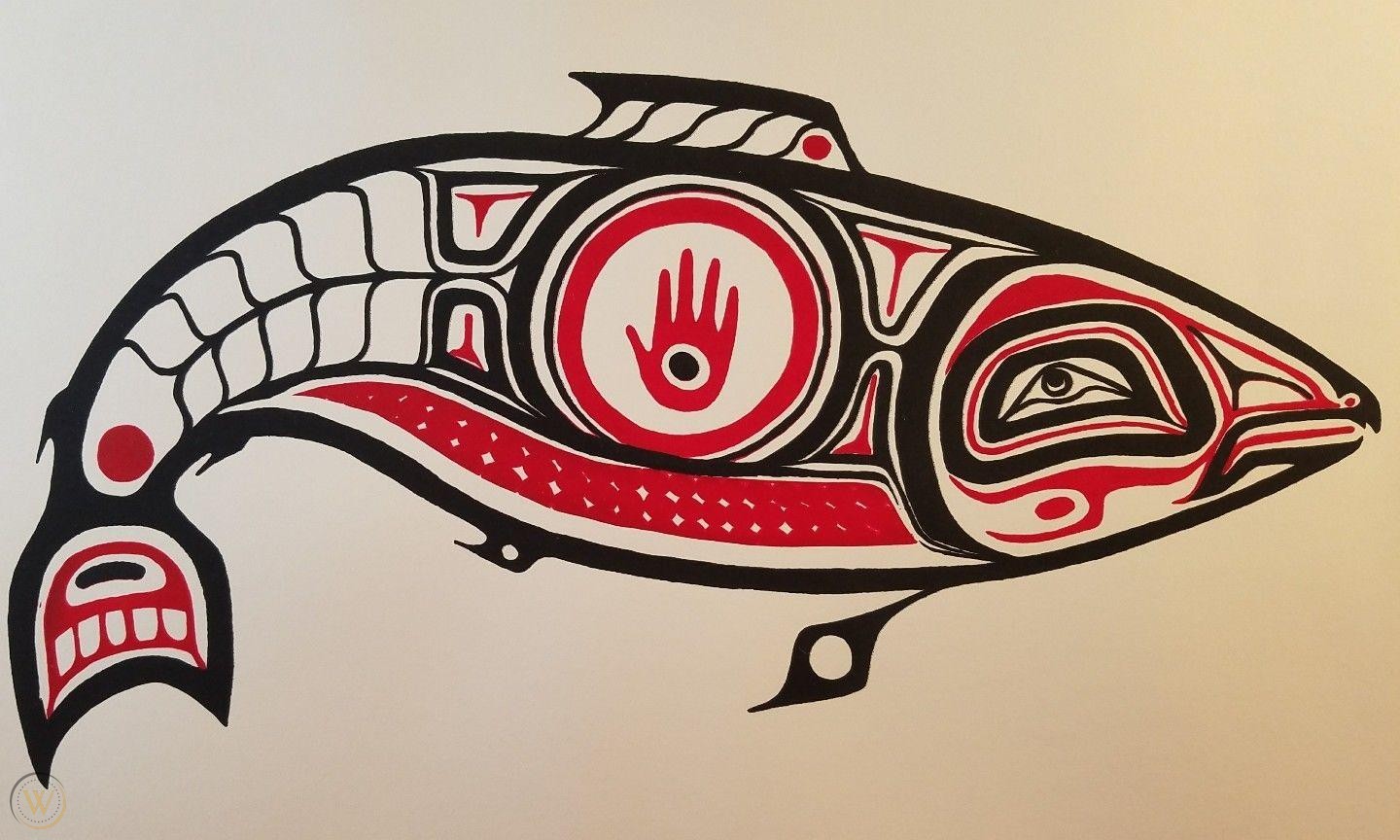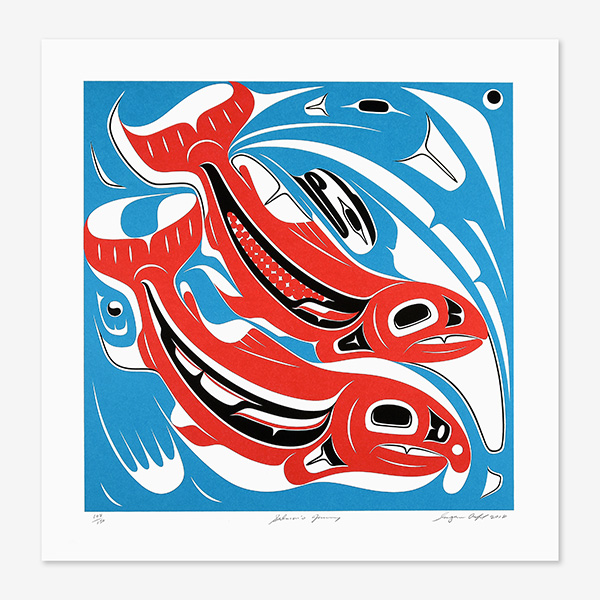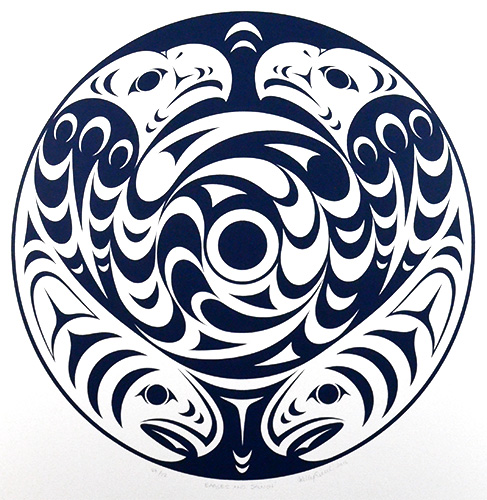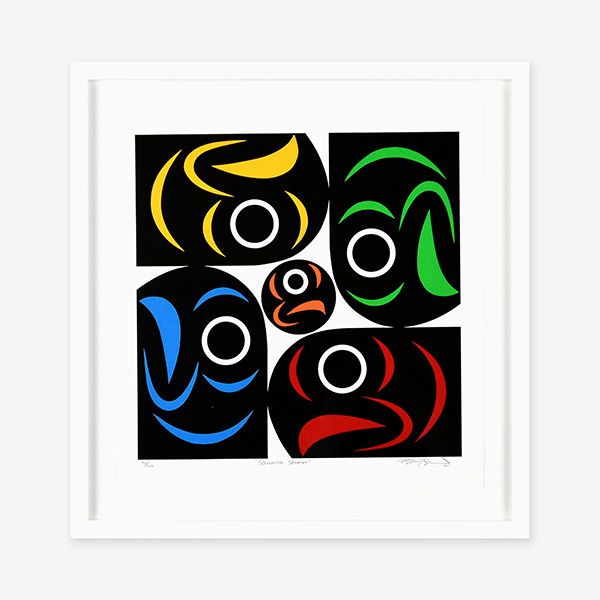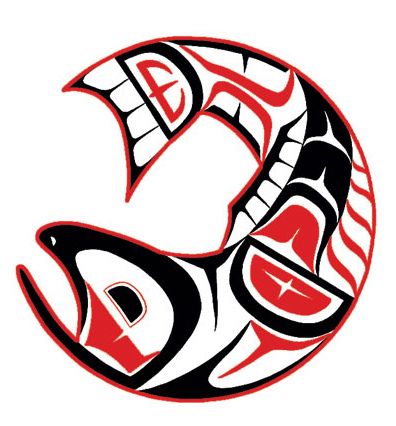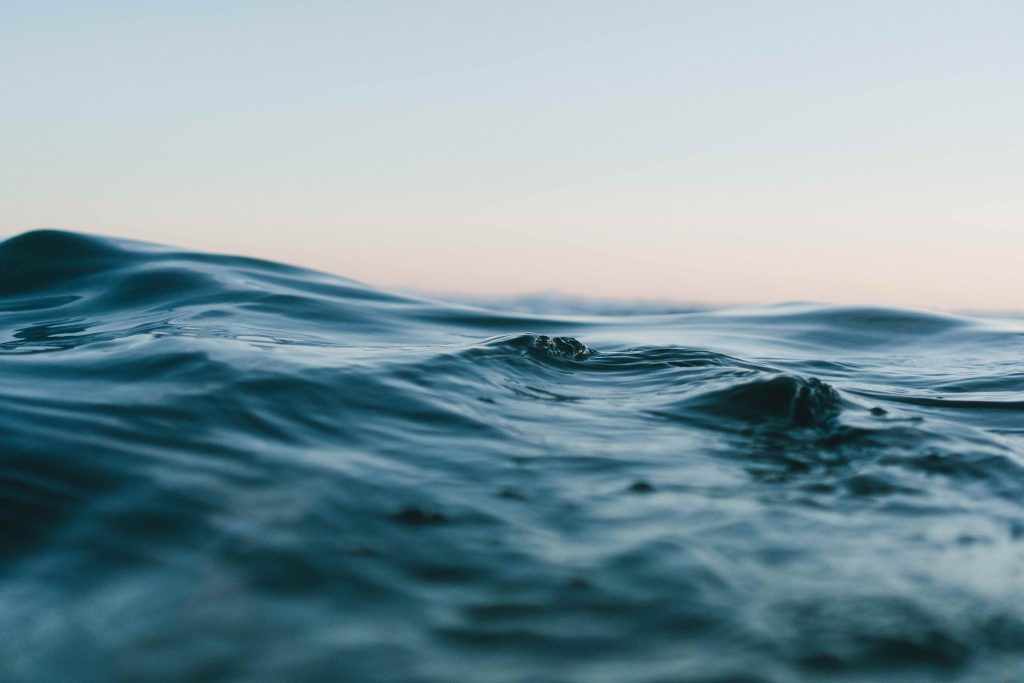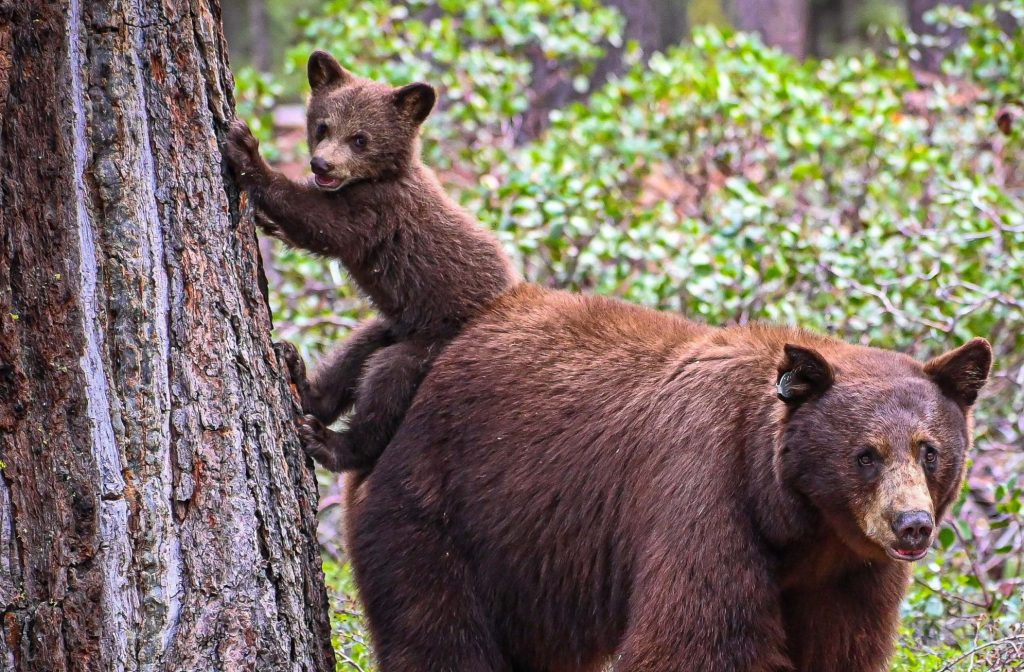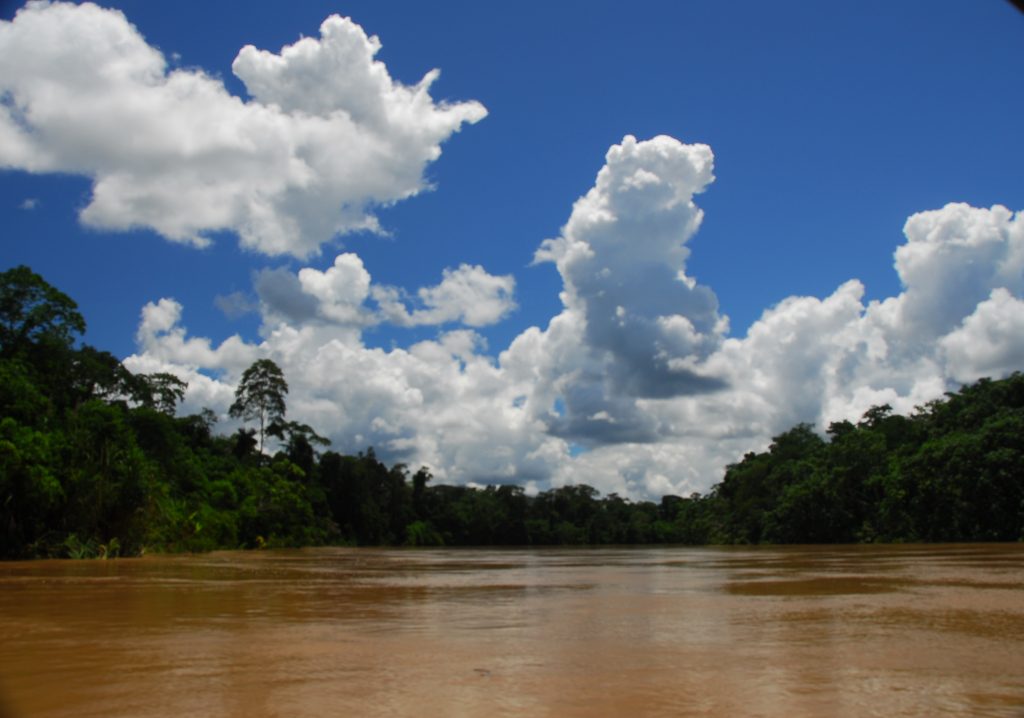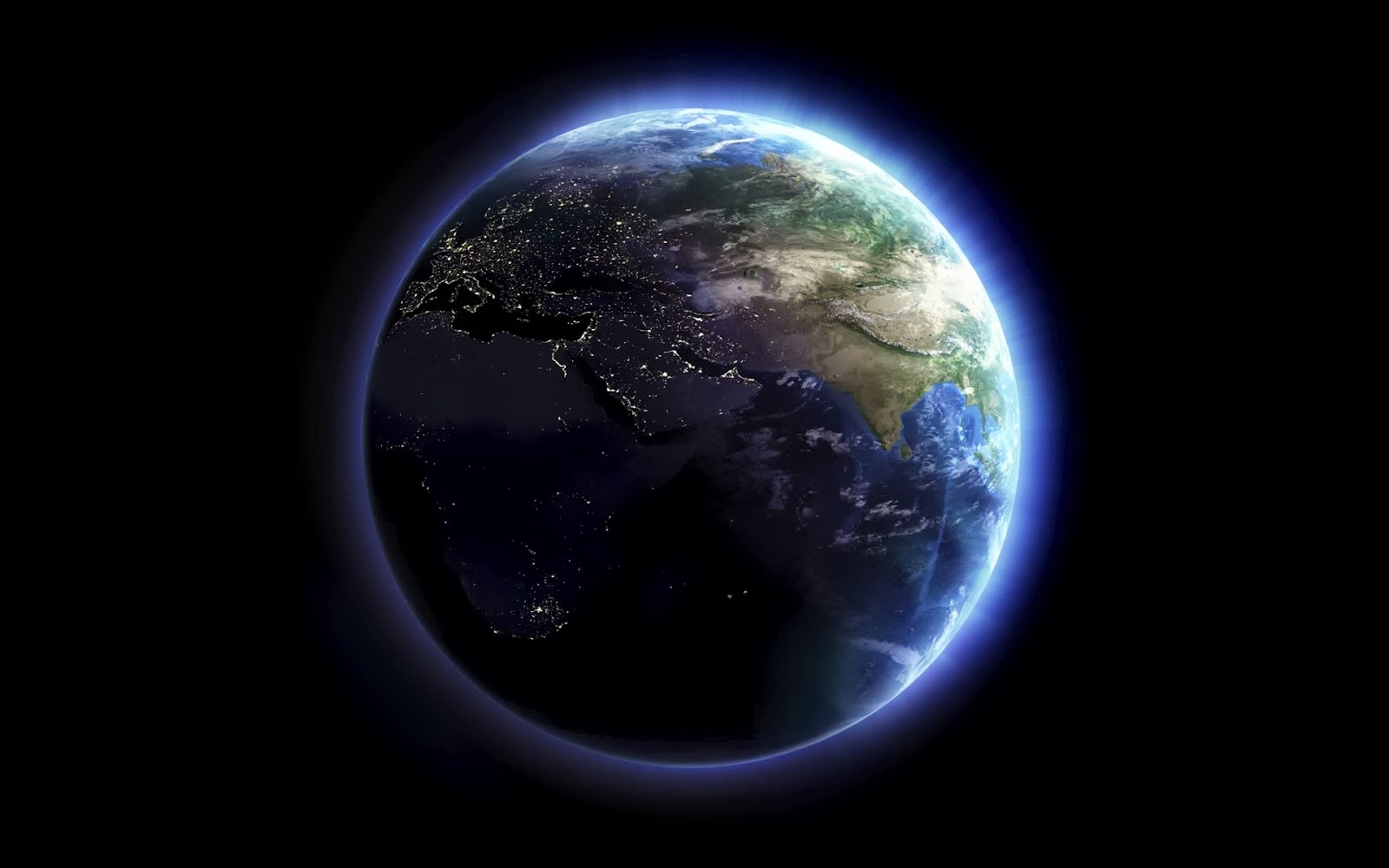Salmon Migration as Earth Expression
Along the Klamath River in what is now California, the primary “first salmon ceremony” was conducted in a Yurok village close by the mouth of the river. After that event, strong runners were sent upriver to alert the Hoopa people that the proper rites had been accomplished, and that the spring salmon were on their way. Upon catching their own first fish, the Hoopa undertook 10 days of ceremony and prayer before allowing generalized fishing to commence. The Karuk people, many miles further upstream, moved away from the river and into the hills while the first salmon was taken and ritually eaten by their spiritual leaders.
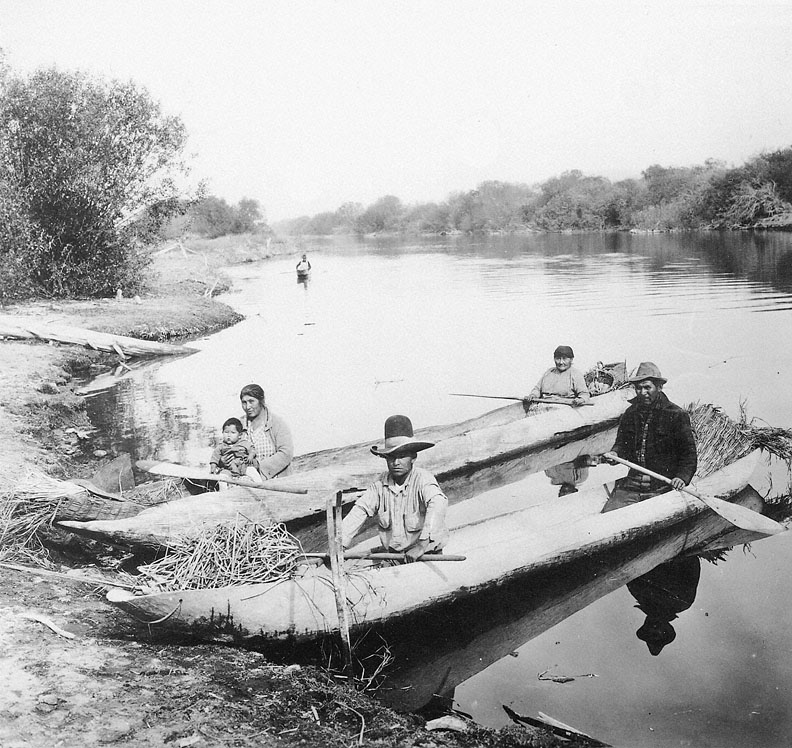
One effect of such ceremonies, and of the restrictions on fishing during their enactment, was that significant numbers of early salmon were enabled to pass freely upriver to their spawning grounds, ensuring the continued replenishment of the run. The ritualized honoring of the first fish also ensured that the salmon, however abundant in the coming season, could not be taken for granted—that its flesh remained a sacrament for the people.
Across the Pacific, among the Ainu people of northern Japan, whenever any family caught the season’s first salmon from the river, the fish was passed through a special window into the house before being placed in front of the hearth fire. There, the family would address the spirit of the salmon directly, honoring it ceremonially with spoken words and ritual gestures. The household fire, for the Ainu, was itself a goddess who could see all that unfolded around her; she would report back to the other gods that the salmon had been treated with proper respect.
The Ainu held ceremonies, too, to bid goodbye to the salmon when, having left their flesh bodies behind as food, they paddled their spirit-boats back to their homes far to the east. Like other native peoples of the North Pacific, the Ainu assumed that the salmon, when they were not crowding upstream to visit the people, removed their salmon garb and lived in human form beyond the ocean horizon. Such a mythic view bound their sensory imagination to the ways of this wild creature, engendering an almost familial regard for its well-being. The view was so widespread that in the nineteenth century when several Skagit Indians from the American northwest accompanied a white expedition back to the east coast and saw the abundance of pale, pink-skinned people living there, they reported back to their tribe that they had been to salmon country and had seen the salmon walking around as human beings.2
More detached and technological approaches to tracking salmon have yielded other ways of describing their whereabouts once they depart the inland waters. Upon leaving their rivers, the salmon seem to spend the largest part of their lives swimming in great circles throughout the North Pacific. Their journeys carry them to the remotest regions of the sea, feeding and growing strong on the ocean’s abundance—on herring and smelt and other small fish—traveling distances that boggle the human mind. After several years dispersing to all points on the horizon, following their food whence it leads them, the members of a single run unerringly return to the mouth of their natal stream—all converging there, somehow, at precisely the same time. How they pull off this feat remains an enigma for present-day science. Once the salmon come close to their home stream, it is probable that they rely on their astonishingly keen sense of smell to distinguish between the subtly different waters of neighboring tributaries. But how the fish navigate across thousands of miles of ever-shifting and largely featureless ocean to make their way back to the very same coastal point from whence they set out years earlier, remains an elemental mystery to us, confounding our primate senses and our terrestrial, pedestrian logic.
Like spring monarch butterflies fluttering north toward specific clumps of milkweed that only their great-grandchildren will reach, like sandhill cranes vibrating the sky with their bugling as they drop toward a tiny patch of peat bog in the broad tundra, the migrating salmon appear to avail themselves of somatic skills far beyond our bodily ken. The only way contemporary science seems able to fathom their uncanny navigational powers is by likening the abilities of these animals to technologies of our own, human invention. We are told, over and again, that these migratory creatures make use of internal maps and internal compasses, of innate calendars and inborn clocks. Clocks, compasses, and calendars, however, are by definition external contrivances, ingeniously built tools that we deploy at will. Metaphorically attributing such instrumentation to other animals has confounding implications, suggesting a curious doubleness in the other creature—a separated sentience or self that regularly steps back, within its body or brain, to consult the map or the calendar.
It seems unlikely, however, that organisms interact with an internal representation of the land in any manner resembling our own engagement with maps. Cranes and butterflies would have little use for a separated re-presentation of the earth’s surface, for they have never torn themselves out of the encompassing presence of the wide earth. Our reliance upon such instrumental metaphors seems to stem from our over-civilized assumption of a neat distinction between living organisms and the non-living terrain that they inhabit, an unambiguous divide between animate life and the ostensibly inanimate planet on which life happens to locate itself. As long as the material ground is considered inert—as long as the elemental atmosphere or ocean is viewed as a passive substrate—then the long-range migrations of certain animals can only be a conundrum, a puzzle we will strive to solve by continually compounding various internal mechanisms that might somehow, in combination, grant a particular creature the power to grapple its way across the world. Instead of hypothesizing more metaphorical gadgets, adding further accessories to a crane’s or a salmon’s interior array of tools, what if we were to allow that the animal’s migratory skill arises from a felt rapport between its body and the breathing Earth? That a crane’s 2000 mile journey across the span of a continent is propelled by the felt unison between its flexing muscles and the sensitive Flesh of this planet (this huge curved expanse, roiling with air currents and rippling with electromagnetic pulses), and so is enacted as much by Earth’s vitality as by the bird that flies within it?
Such a conception need not contradict any of the accepted evidence gathered from a century’s research into the enigmas of animal migration; it simply offers a new way of interpreting and integrating those various evidences. By focusing our questions so intently on the organism, as if it carries all the secrets of this magic hidden inside itself, we easily lose sight of the obvious collaboration at play. By adding new gadgets to an animal’s neurological and genetic endowment, we tacitly induce ourselves to focus upon relationships interior to the organism (how, for example, does the animal bring its biological clock and its internal map to bear on its compass readings), deflecting our curiosity and attention from the more mysterious relationship that calls such interactions into being.
What is this dynamic alliance between an animal and the animate orb that gives it breath? What seasonal tensions and relaxations in the atmosphere, what subtle torsions in the geosphere help to draw half a million cranes so precisely across the continent? What rolling sequence or succession of blossomings helps summon these millions of butterflies across the belly of the land? What alterations in the olfactory medium, what bursts of solar exuberance through the magnetosphere, what attractions and repulsions…?
Salmon Spirit
Northwest Coast Art is the term commonly applied to a style of art created primarily by artists from Tlingit, Haida, Heiltsuk, Nuxalk, Tsimshian, Kwakwaka’wakw, Nuu-chah-nulth, and other First Nations and Native American tribes of the Northwest Coast of North America, from pre-European-contact times up to the present.
Learn more about this art: Established in 1996, Coastal Peoples Gallery has brought visitors and collectors together to experience a superb collection of fine First Nations and Inuit artworks.
For surely, really and truly, these migratory creatures are not taking readings from technical instruments nor mathematically calculating angles; they are riding waves of sensation, responding attentively to allurements and gestures in the topological manifold, reverberating subtle expressions that reach them from afar. These beings are dancing not with themselves but with the animate rondure of the earth, their wider Flesh!
Consider the deep somatic attunement by which a salmon feels its way between faint electromagnetic anomalies, riding a particular angle of sun as it filters down through the rippled surface, gliding with certain currents and plunging up against others, dreaming its way through gradients of scent and taste toward a particular bend of gravel and streamside shadow. Whatever specialized sensitivities and internal organs are brought to bear, those very organs have co-evolved with textured patterns and pulses actively propagating through the elemental medium; indeed, those sensitivities have often been provoked by large-scale repetitive or rhythmic happenings proper to that part of the biosphere—by pulsed coalescences and cyclic dispersals—and so can hardly be fathomed without reference to these patterned gestures within the Body of the planet.
Perhaps it would be useful, now and then, to consider the large, collective migrations of various creatures as active expressions of the earth itself. To consider them as slow gestures of a living geology, improvisational experiments that gradually stabilized into habits now necessary to the ongoing metabolism of the sphere. For truly: are not these cyclical pilgrimages—these huge, creaturely hegiras—also pulsations within the broad Body of the earth? Are they not ways that divergent places or ecosystems communicate with one another, trading vital qualities essential to their continued flourishing?
Think again of the salmon, this gift born of the rocky gravels and melting glaciers, nurtured by colossal cedars and by tumbled trunks decked with ferns, fungi, and moss, an aquatic, muscled energy strengthening itself in the mossed and forested mountains until it’s ready to be released into the broad ocean. Pouring seaward, it adds itself to that voluminous cauldron of currents spiraling in huge gyres, shaded by algal blooms and charged by faint glissandos of whale song… Until, grown large with the sea’s abundance, this ocean-infused life flows back up the rivers and tributaries and spreads out into the wooded valleys, gifting the hollows and the needled highlands with new minerals and nutrients, feeding bears and osprey and eagles, ensuring that the glinting gift will be reborn afresh from a lump of luminous eggs stashed beneath a layer of pebbles.
This circulation, this systole and diastole,3 is one of the surest signs that this earth is alive—a rhythmic pulse of silvery, glacier-fed brilliance pouring through various arteries into the wide body of the ocean, circulating and growing there, only to return by various veins to the beating heart of the forest, gravid with new life.
Or… perhaps it’s better to think of this seasonal reciprocity as a kind of breathing, as an exhalation of millions of young salmon smolts down from the tree-thick mountains and meadows and then out into the roiling cosmos of currents and tidal flows, to mingle with zooplankton and seals and squids, and then the great in-breath, the drawing in of living nourishment from the sea into river mouths and estuaries, inhaling the salmon up those rivers into streams, and from there into the branching becks, rills, and runnels that filter into the green forests, the living lungs of this biosphere. Or is it the broad-bellied ocean that is breathing, sucking these finned nutrients down from the shaded slopes, luring them over rocks and through rapids and hydroelectric dam spillways—drawing them past bustling cities and factories, through intersecting gradients of toxic effluents that sting their mouths and strafe their exposed membranes—on out into the heaving whirl of the sea’s innards, the writhe and foam of the ocean circulating this glimmering nourishment within itself before exhaling it back, a long sighing breath, up into the wooded valleys?
However else we may view them, these deterritorializations and reterritorializations—these large migrations of various species—are a primary way that the biosphere cleanses and flexes its various organs, replenishing itself: each region drawing insights from the others, concentrating and transforming such qualities before releasing them abroad, divergent places trading perspectives along with nutrients and nucleotides, the whole half-shadowed sphere steadily experimenting, improvising, slowly altering its display to the blazing fire watching from afar, as the reflective moon rolls on ’round.
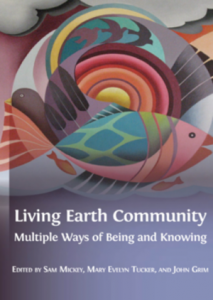
Excerpted from the free Open Source Book, Living Earth Community: Multiple Ways of Being and Knowing, a collection of the “Living Earth Community” conference papers. Edited by Sam Mickey, Mary Evelyn Tucker, and John Grim; Open Book Publishers, 2020.
This anthology examines the interplay between Nature and Culture in the setting of our current age of ecological crisis, stressing the importance of addressing these ecological crises occurring around the planet through multiple perspectives.
Read this online open source book for free here. See interviews with authors here.
Bibliography
Collins, June McCormick, “The Mythological Basis for Attitudes towards Animals among Salish-Speaking Indians,” Journal of American Folklore, 65 (1952), 353–59.
1 This chapter is an excerpt from “Creaturely Migrations on a Breathing Planet”—a long essay reflecting upon the wild sandhill crane, Pacific salmon, and monarch butterfly migrations, published in the inaugural issue of Emergence (an online magazine launched on Earth Day, 2018). The full essay is published here in both textual and auditory form (read by the author).
2 June McCormick Collins, “The Mythological Basis for Attitudes towards Animals among Salish-Speaking Indians,” Journal of American Folklore, 65 (1952), 353–59.
3 The two phases of the cardiac cycle.



